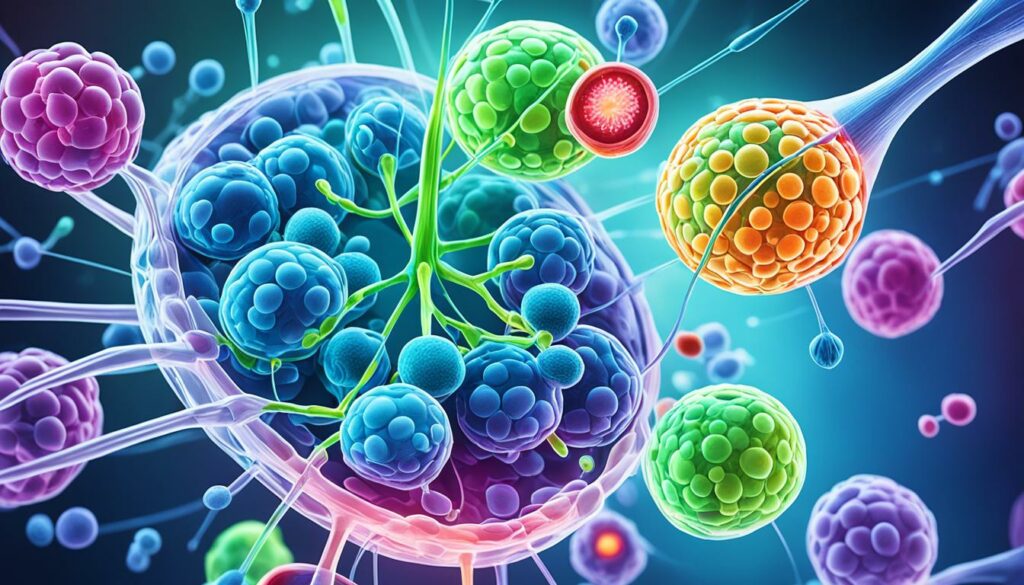Are you looking for an advanced treatment option for lymphoma? Have you heard about the potential of stem cell therapy in battling this aggressive cancer?
Discover how the innovative approach of stem cell transplants can renew your hope for remission and a better quality of life.
Lymphoma is a challenging disease that often requires intensive treatment strategies. Traditional approaches like chemotherapy and radiation have been the conventional go-to options, but the medical field is constantly evolving to offer more effective and personalized treatments. Stem cell therapy has emerged as a promising breakthrough for lymphoma patients, revolutionizing the way we fight this cancer.
In this comprehensive guide, we will explore the world of stem cell therapy for lymphoma treatment. From understanding the role of stem cell transplants in battling lymphoma to the benefits and risks associated with this innovative treatment, we will delve into every aspect.
Keep reading to discover the process of stem cell therapy, the different types of stem cell transplants, how stem cells renew the bone marrow after chemotherapy, and the challenges and solutions associated with allogeneic transplants. We will also provide insights into the recovery phase after a stem cell transplant and the long-term support and monitoring necessary for lymphoma survivors.
Key Takeaways:
- Stem cell therapy offers a promising treatment option for lymphoma patients.
- Stem cell transplants play a crucial role in renewing the bone marrow and replacing damaged cells.
- There are two types of stem cell transplants: autologous and allogeneic.
- Stem cells have the ability to renew the bone marrow and restore its function after chemotherapy.
- Stem cell transplants come with both benefits and risks that need careful consideration.
Understanding Stem Cell Therapy as a Treatment for Lymphoma
In the battle against lymphoma, stem cell transplants play a crucial role in rebuilding the bone marrow and replacing damaged cells. Stem cell therapy offers promising treatment options for lymphoma patients, aiming to improve remission rates and long-term outcomes. This section will explore the role of stem cell transplants in battling lymphoma, the types of stem cell transplants available, and the ability of stem cells to renew bone marrow after chemotherapy.
The Role of Stem Cell Transplants in Battling Lymphoma
Stem cell transplants are an integral part of lymphoma treatment, especially in cases where chemotherapy alone may not be sufficient. These transplants help to replenish the bone marrow and restore its function, which is crucial for the production of healthy blood cells.
Types of Stem Cell Transplants: Autologous and Allogeneic
There are two main types of stem cell transplants used in lymphoma treatment: autologous and allogeneic. Autologous stem cell transplants involve using the patient’s own stem cells, collected before undergoing chemotherapy. This type of transplant eliminates the risk of graft-versus-host disease but may not be suitable for all patients.
On the other hand, allogeneic stem cell transplants utilize donor stem cells, often obtained from a sibling or an unrelated donor. While allogeneic transplants carry a higher risk of graft-versus-host disease, they offer the advantage of potential graft-versus-lymphoma effect, where the donor’s immune cells actively attack the lymphoma cells.
Stem Cells and Their Ability to Renew Bone Marrow after Chemotherapy
Stem cells have the remarkable ability to renew and regenerate various types of tissues, including the bone marrow. When used in stem cell therapy, these cells can help replenish the bone marrow after chemotherapy-induced damage. The transplanted stem cells migrate to the bone marrow and differentiate into different types of blood cells, thereby restoring the body’s ability to produce healthy blood cells.
The Process of Stem Cell Therapy for Lymphoma
The process of stem cell therapy for lymphoma involves several stages. It is a carefully managed treatment that aims to use stem cells to combat the disease and promote healing. Let’s explore the key steps in this therapy.
1. Stem Cell Collection: The first step in the process is collecting stem cells. These cells can be sourced from the patient themselves (autologous) or a donor (allogeneic). The collection process may involve extracting stem cells from the patient’s bloodstream or bone marrow.
2. Conditioning Therapy: After stem cell collection, the patient undergoes conditioning therapy. This typically includes high-dose chemotherapy and, in some cases, radiation. The aim of conditioning therapy is to prepare the body for the stem cell infusion by eliminating cancerous cells and suppressing the immune system.
3. Stem Cell Infusion: Once the patient has completed the conditioning therapy, the collected or donated stem cells are infused back into their bloodstream. The stem cells then travel to the bone marrow, where they take root and begin to produce healthy blood cells.
4. Healing and Recovery: Following the stem cell infusion, the patient’s body undergoes a healing and recovery process. The new stem cells gradually regenerate and restore the bone marrow, leading to the production of healthy blood cells. This helps to strengthen the immune system and fight against lymphoma.
Throughout the stem cell therapy process, the patient is closely monitored and supported by a specialized medical team. Regular check-ups and follow-ups are crucial to ensure the effectiveness of the treatment and mitigate any potential complications.

| Stage | Description |
|---|---|
| Stem Cell Collection | Obtaining stem cells from the patient or a donor through a specific collection procedure. |
| Conditioning Therapy | Administration of high-dose chemotherapy and sometimes radiation to prepare the patient’s body for stem cell infusion. |
| Stem Cell Infusion | The collected or donated stem cells are reintroduced into the patient’s bloodstream. |
| Healing and Recovery | The new stem cells start rebuilding the bone marrow and producing healthy blood cells, aiding in the healing process. |
Benefits and Risks Associated with Stem Cell Transplants
Stem cell transplants offer several benefits in the treatment of lymphoma. One of the key ways they enhance treatment outcomes is through high-dose chemotherapy and stem cell support, which can improve remission rates. By delivering intensified chemotherapy, high-dose regimens aim to eradicate cancer cells more effectively. The subsequent infusion of stem cells facilitates the recovery and renewal of the bone marrow, essential for replenishing healthy blood cells.
Despite the potential benefits, it is important to consider the associated risks and side effects of stem cell transplants. Common side effects include nausea, fatigue, and an increased susceptibility to infections due to the temporary weakening of the immune system. These side effects can be managed effectively with appropriate care and support from a specialized medical team, which includes careful monitoring, medication, and infection prevention measures.
One specific challenge that arises with allogeneic transplants, where donor stem cells are used, is graft-versus-host disease (GVHD). GVHD occurs when the donor’s immune cells recognize the recipient’s body as foreign and attack healthy tissues. Managing GVHD requires targeted strategies to suppress the immune response while preserving the graft-versus-tumor effect. Close monitoring and customized treatment plans are crucial to minimize the impact of GVHD and enhance patient outcomes.
Overall, while stem cell transplants offer significant benefits in achieving remission rates and restoring healthy bone marrow function, it is essential to carefully navigate the potential risks and side effects associated with the procedure. By effectively managing side effects such as nausea, fatigue, and infections, and addressing the challenges posed by graft-versus-host disease, medical professionals can ensure successful and safe stem cell transplantation for lymphoma patients.
Recovery and Life After Stem Cell Transplantation
After undergoing a stem cell transplant, the recovery process requires a comprehensive approach to ensure successful outcomes. Navigating the post-transplant phase is essential, and this stage involves close monitoring and follow-up to address any potential complications that may arise.
Physical support plays a crucial role in the recovery of stem cell transplant patients. This includes the use of medications and making necessary lifestyle adjustments to promote healing and improve overall well-being. The healthcare team will provide guidance on managing symptoms and optimizing physical health.
Equally important is the provision of psychological support. Stem cell transplantation can have a significant emotional impact on patients due to the intensive treatment and the uncertainty that comes with it. It is essential for patients to have access to counseling services and support groups to address any anxiety, depression, or other psychological challenges that may arise during the recovery process.
Long-term monitoring and follow-up are critical for lymphoma survivors who have undergone stem cell transplantation. Regular check-ups and diagnostic tests are necessary to track the patient’s health, detect any potential relapse or complications, and ensure early intervention if needed. This ongoing monitoring provides reassurance and proactive management of the patient’s well-being.

| Support After Stem Cell Transplant | Physical | Psychological | Long-Term Monitoring |
|---|---|---|---|
| Medications | Counseling services | Regular check-ups and tests | |
| Lifestyle adjustments | Support groups | Early detection of complications |
Conclusion
Stem cell therapy offers hope and advanced treatment options for lymphoma patients. The therapy has shown promising results in improving remission rates and long-term outcomes. By utilizing stem cell transplants, patients have the opportunity to renew their bone marrow and replace damaged cells, increasing their chances of remission and cure.
However, it is crucial to weigh the benefits and risks before undergoing a stem cell transplant. While the therapy offers potential benefits, it also carries risks and potential side effects. Common side effects include nausea, fatigue, and an increased risk of infections. Managing these side effects is essential for a successful transplantation process.
Recovery and life after a stem cell transplant require comprehensive support and monitoring. Both physical and psychological support play a vital role in helping patients navigate the post-transplant phase. Medications, lifestyle adjustments, and emotional support are all crucial elements in ensuring a successful recovery. Long-term monitoring and follow-up are necessary to track the patient’s health and detect any potential complications.
With proper care and support, lymphoma survivors can lead fulfilling lives after stem cell transplantation. While the journey may have its challenges, the advancements in stem cell therapy provide hope for improved outcomes. By considering the benefits, risks, and taking advantage of the comprehensive support available, patients can increase their chances of successful treatment and long-term recovery.
FAQ
What is stem cell therapy for lymphoma treatment?
Stem cell therapy is a promising treatment option for lymphoma patients. It involves the use of stem cell transplants to help battle lymphoma.
What are the types of stem cell transplants used in lymphoma treatment?
There are two types of stem cell transplants used in lymphoma treatment: autologous transplant, which uses the patient’s own stem cells, and allogeneic transplant, which uses donor stem cells.
How do stem cells renew the bone marrow after chemotherapy?
Stem cells have the ability to renew the bone marrow and restore its function. They are used after chemotherapy to increase the chances of remission and cure.
What is the process of stem cell therapy for lymphoma?
The process involves collecting stem cells from the patient or a donor, undergoing conditioning therapy (high-dose chemotherapy and possibly radiation), and infusing the collected or donated stem cells back into the patient’s bloodstream.
What are the benefits and risks associated with stem cell transplants?
Stem cell transplants can improve remission rates in lymphoma patients. However, they also carry potential side effects and risks, such as nausea, fatigue, and increased risk of infections. Managing side effects and graft-versus-host disease in allogeneic transplants is crucial for successful transplantation.
What is the recovery like after a stem cell transplant?
Recovery after a stem cell transplant requires a comprehensive approach. Patients need to navigate the post-transplant phase, receive physical and psychological support, and undergo long-term monitoring and follow-up to track their health and detect any potential complications.
Can lymphoma survivors lead fulfilling lives after stem cell transplantation?
With the right support and care, lymphoma survivors can lead fulfilling lives after stem cell transplantation. Stem cell therapy offers hope and advanced treatment options for lymphoma patients, improving remission rates and long-term outcomes.



